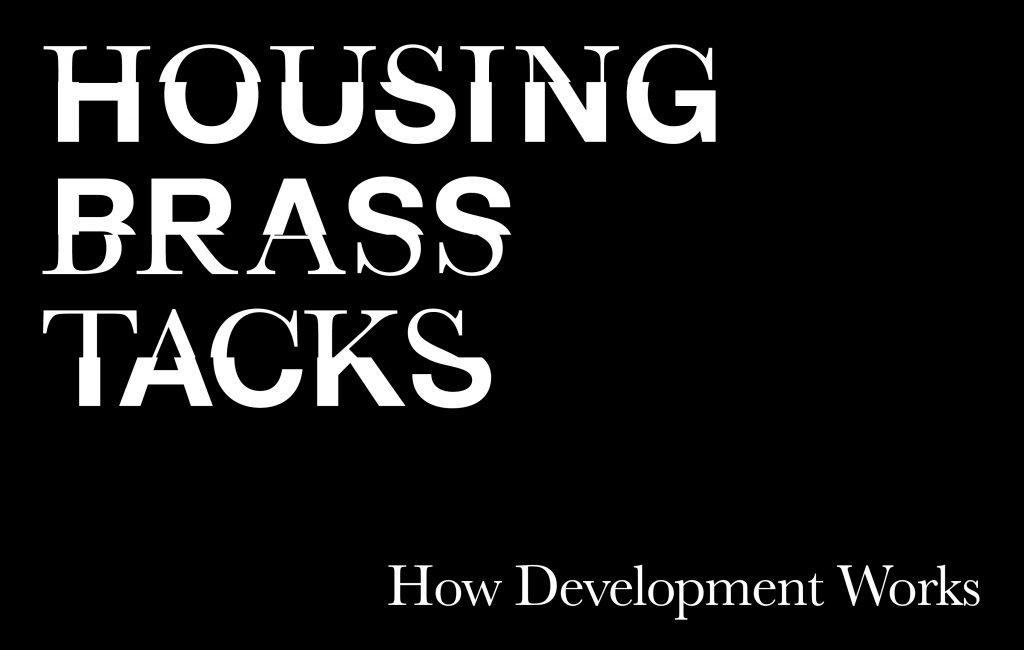
How development works
Housing Brass Tacks is an informal discussion series designed as a primer on big ideas and essential mechanics in housing policy and development.
June 5, 2017
7:00 p.m.
Rapid population growth, record numbers of homeless families and individuals, increasing income inequality, and a public housing waiting list a quarter-million names long all speak to the dire shortage of affordable housing in New York City. There’s increasing need for more—and more affordable—housing and to preserve the units we already have. One critical component to meeting this shortage is the construction of new units, which mostly come in the form of publicly subsidized rental apartments. But who builds affordable housing and how do they make it work? Are there differences in the approaches of nonprofit and for-profit developers?
In our ninth Brass Tacks discussion, two mission-driven affordable housing developers will discuss the essentials of the development process in New York City today. In a conversation moderated by Jarrett Murphy of City Limits, Michelle de la Uz of the nonprofit Fifth Avenue Committee and Martin Dunn of the for-profit Dunn Development Corp. will detail how they identify projects, whom they partner with, where the financing comes from, whom their buildings serve, and more.
Ample time for questions will follow their conversation. You bring the questions, we’ll supply the experts and the wine.
Michelle de la Uz became Executive Director of Fifth Avenue Committee, Inc. in 2004. She has over 25 years of experience in public and community service, today overseeing the FAC’s programs serving more than 5,500 low- and moderate-income people. Previously, she was the Program Director for the Center for Urban Community Services and was Congresswoman Nydia Velázquez’s first Director of Constituent Services. Michelle is a recipient of the Ford Foundation’s Leadership for a Changing World award and serves on the boards of LISC, the New York Housing Conference, and the Association for Neighborhood and Housing Development. She was appointed in 2012 to the New York City Planning Commission, and reappointed in 2016. An alumna of Connecticut College, Columbia University, and Harvard Kennedy School’s Executive Program, Michelle lives in Brooklyn with her husband and daughter.
Over the last 25 years, Martin Dunn has been involved in the development of more than 3,500 units of new housing. Since 1998, he has been President of Dunn Development Corp., a socially conscious real estate developer whose mission is to build the highest quality housing for low and middle-income New Yorkers, including those with disabilities and other special needs. Previously, he was the Executive Director of the nonprofit East New York Urban Youth Corps and worked at the Association to Benefit Children. He serves on the boards of Hour Children, the Supportive Housing Network of New York, the New York State Association for Affordable Housing, and the Citizens Housing and Planning Council. Martin holds a B.A. in Political Science from Cornell University.
Jarrett Murphy is the Executive Editor and Publisher of the independent, investigative news site City Limits, where he has worked since 2007.
About Housing Brass Tacks
Understanding housing policy, finance, and regulation is daunting. One must wade through a sea of acronyms, untangle public and private interests, trace knotty financial flows, and decrypt complex bureaucracies. Making heads or tails of all this can take a lifetime, but the need to understand is urgent. We all feel New York City’s housing squeeze; increased affordable housing is a centerpiece of our mayor’s agenda; and sweeping changes in housing and community development policy may soon come at the federal level. The Architectural League is here to introduce (or refresh) our housing proficiency. Housing Brass Tacks is an informal discussion series designed as a primer on big ideas and essential mechanics in housing policy and development. We’re getting down to brass tacks: the fundamentals that structure this unwieldy topic.


